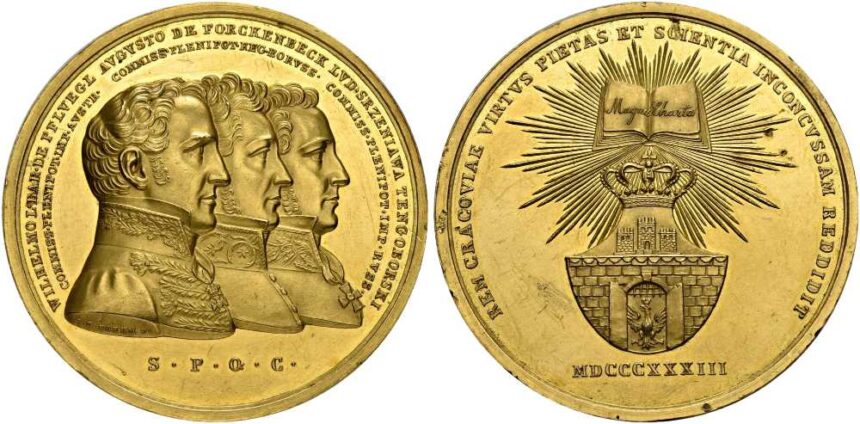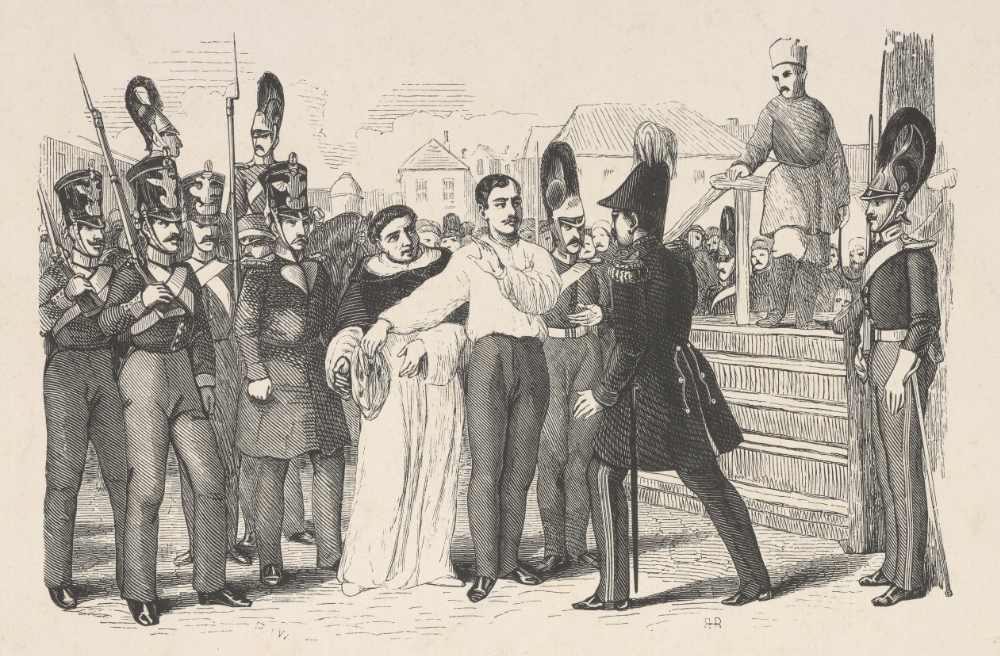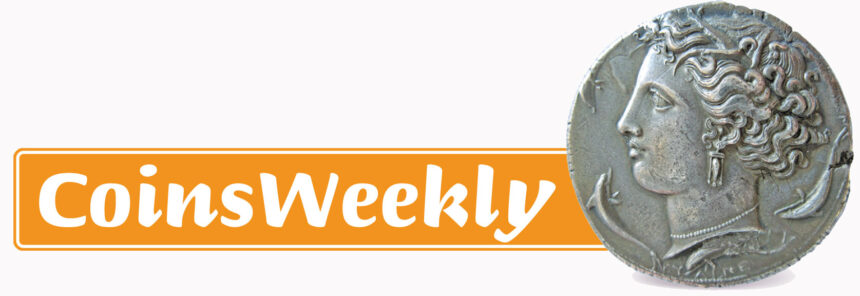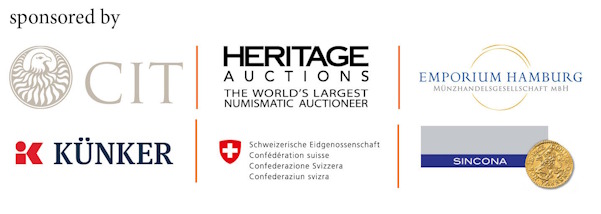The Krakow Constitution of 1833
Prussia, Austria, and Russia divided Poland among themselves. But Poland did not disappear. Polish nationalists rose up in repeated uprisings to reclaim their land. This had dire consequences for the population, as evidenced by a medal awarded to the victors.

“Poland is not yet lost, as long as we live. What foreign superiority has taken from us, we will regain with the sword.” Poles sing these words every time they sing their national anthem. They remind them of their history: after the Congress of Vienna, the Polish nation existed only in the minds of its citizens. This resulted in many large and small uprisings against the occupying powers. In most cases, these worsened the situation for the civilian population. This was also the case in May 1833, when guerrilla fighters gave the occupiers of Krakow a welcome excuse to impose a new constitution on the city. A gold medal from the 100th SINCONA auction, of which only one copy remains, serves as a reminder of this. It will be auctioned in Zurich on October 30, 2025.
What can be seen on this medal?
The front shows portraits of three men in uniform, from right to left. They are the Austrian Wilhelm Freiherr von Pflügl-Lissinetz (in the foreground), the Prussian August von Forckenbeck (in the middle), and the Russian Ludwig Walerianowitsch Tengoborski (at the back). They served as commissioners of the “Free City of Krakow” and controlled the city’s institutions on behalf of their rulers from May 1833 onwards. The inscription lists their names and titles in Latin, with the abbreviation SPQC below. This stands for the Senate and People of Krakow, in reference to the better-known SPQR. This implies that the citizens of Krakow commissioned this medal.
The signature of the engraver Joseph Daniel Böhm can be seen on the arm section of the Austrian commissioner Pflügl. As director of the Imperial and Royal Academy of Engraving in Vienna, Böhm often worked for the Vienna Mint. This, and the fact that the Austrian commissioner occupies the ceremonial position of honor on the medal, suggests that it was the Austrian administration, rather than the citizens of Krakow, who were in charge.
The reverse side shows the crowned coat of arms of the Free City of Krakow: it depicts a fortress with three towers and an open gate, in which the (white) eagle refers to Poland. Above it is the new constitution, symbolized by an open book in a halo with the inscription Magna Charta. The Latin inscription means (in translation) The virtue, piety, and competence of the Krakow state have made it unshakeable 1833.
What connection does this medal have to the Krakow Uprising of 1833?
After the failed uprising of 1830/31, many Polish nationalists fled abroad, mainly to Paris. There they wondered how to proceed. The Polish cause must not be forgotten!
One of them, Józef Zaliwski, founded the secret society “Zemsta Ludu” (= Revenge of the People). Together with other nationalists, he planned to wage guerrilla warfare from Krakow against Tsarist-ruled Poland. Around 100 revolutionaries joined him. From March 1833 onwards, they carried out minor attacks on military installations and tried to persuade the peasants to join the resistance.
At that time, Krakow had special status as a “free city.” Formally, it was an autonomous and independent republic with a senate and a representative assembly. In practice, this republic was supervised by one Austrian, one Prussian, and one Russian commissioner. Even though this function was purely diplomatic, the Austrians in Krakow had an extensive network of informants, organized by police officer Franz Guth. Thanks to his informants, he exposed the guerrilla fighters within a few weeks, so that “Zemsta Ludu” was already history by May 1833. The conspirators were captured and brought to trial. Józef Zaliwski was sentenced to 20 years in prison. Artur Zawisza, just 24 years old, died by hanging in Vilnius. He is still considered a martyr of Polish independence today.

This had significant consequences for Krakow. In May 1833, the three occupying powers imposed a new constitution on the “free” city: the “Magna Carta” depicted on the medal shown here. This is ironic. The first and famous Magna Carta guaranteed the rights of the ruled against the ruler.
The Krakow constitution wanted the opposite. It transferred all political rights to the three commissioners. Their approval was just as indispensable for the election of a Senate president as it was for all other Senate decisions. The police were placed under the authority of an Austrian official, namely Franz Guth, who had so effectively crushed the freedom movement thanks to his informers. The Krakow courts were stripped of their jurisdiction in political cases. In addition, a censorship authority now monitored the press and the university.
Furthermore, the constitution gave the protecting powers the authority to station an occupation force in the event of threats. This paved the way for the Austrian annexation of the city in 1846/7.
What is this unique Polish medal worth?
Poland can be proud of its active and enthusiastic collectors, which has led to Polish coins and medals currently experiencing an all-time high. Therefore, the CHF 40,000 estimated by SINCONA for the medal should actually be considered a starting price. This is because several factors that increase the value of this medal come together: Gold medals in the finest condition are currently enjoying high international attention. Added to this is the high emotional value that this medal has for Poles, who are proud of their country. We will publish the result here after the auction.
The catalogs for the SINCONA auctions from October 27 to 30, 2025, can be found on the SINCONA website. Click here to go to the overview page of all auctions. This link takes you directly to the lot we are presenting.
If you are not yet familiar with the Polish national anthem, here you can listen to a version with the English translation displayed.
Text and images: Ursula Kampmann

